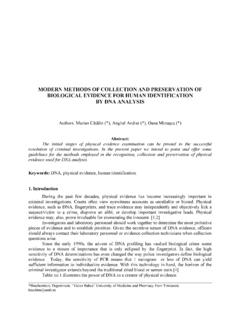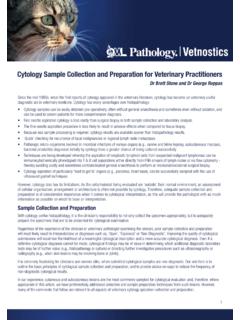Transcription of MODERN METHODS OF COLLECTION AND PRESERVATION …
1 MODERN METHODS OF COLLECTION AND PRESERVATION OF BIOLOGICAL EVIDENCE FOR HUMAN IDENTIFICATION BY DNA ANALYSIS Authors: Marian C t lin (*), Anghel Andrei (*), Oana Mitra ca (*) Abstract: The initial stages of physical evidence examination can be pivotal to the successful resolution of criminal investigations. In the present paper we intend to point and offer some guidelines for the METHODS employed in the recognition, COLLECTION and PRESERVATION of physical evidence used for DNA analysis. Keywords: DNA, physical evidence, human identification. 1. Introduction During the past few decades, physical evidence has become increasingly important in criminal investigations. Courts often view eyewitness accounts as unreliable or biased. Physical evidence, such as DNA, fingerprints, and trace evidence may independently and objectively link a suspect/victim to a crime, disprove an alibi, or develop important investigative leads.
2 Physical evidence may, also, prove invaluable for exonerating the innocent. [1,2] Investigators and laboratory personnel should work together to determine the most probative pieces of evidence and to establish priorities. Given the sensitive nature of DNA evidence, officers should always contact their laboratory personnel or evidence COLLECTION technicians when COLLECTION questions arise. Since the early 1990s, the advent of DNA profiling has vaulted biological crime scene evidence to a stature of importance that is only eclipsed by the fingerprint. In fact, the high sensitivity of DNA determinations has even changed the way police investigators define biological evidence. Today, the sensitivity of PCR means that 1 nanogram or less of DNA can yield sufficient information to individualize evidence.
3 With this technology in-hand, the horizon of the criminal investigator extends beyond the traditional dried blood or semen stain.[4] Table illustrates the power of DNA as a creator of physical evidence. *Biochemistry Department, Victor Babes University of Medicine and Pharmacy from Timisoara Evidence Possible Location of DNA on the Evidence Source of DNA baseball bat or similar weapon Handle, end sweat, skin, blood, tissue hat, bandanna, or mask Inside sweat, hair, dandruff eyeglasses Nose or ear pieces, lens sweat, skin facial tissue, cotton swab Surface area mucus, blood, sweat, semen, ear wax dirty laundry Surface area blood, sweat, semen toothpick Tips saliva used cigarette Cigarette butt saliva stamp or envelope Licked area saliva tape or ligature Inside/outside surface skin.
4 Sweat bottle, can, or glass Sides, mouthpiece saliva, sweat used condom Inside/outside surface semen, vaginal or rectal cells blanket, pillow, sheet surface area sweat, hair, semen, urine, saliva through and through bullet outside surface blood, tissue bite mark person s skin or clothing saliva fingernail, partial fingernail Scrapings blood, sweat, tissue Table no. 1. DNA as evidence Note that, in practice, crime scenes samples may contain considerably less usable DNA depending on environmental conditions. DNA has been isolated from other sources, such as gastric fluids and fecal stains. However, it can be difficult to generate a DNA profile from these sources in case samples due to significant degradation. Several factors affect the ability to obtain a DNA profile. The sensitivity of PCR DNA typing METHODS is noteworthy, but still limited.
5 The second concern is sample degradation. Prolonged exposure of even a large bloodstain to the environment or to bacterial contamination ca degrade the DNA and render it unsuitable for further analysis. The third consideration is sample purity and DNA content of different types of samples, as shown in table TYPE OF SAMPLE AMOUNT OF DNA liquid blood 20000-40000 ng/ml bloodstain 250-500 ng/cm2 liquid semen 150000-300000 ng/ml postcoital vaginal swab 10-3000 ng/swab plucked hair with root 1-750 ng/root shed hair with root 1-10 ng/root liquid saliva 1000-10000 ng/ml oral swab 100-1500 ng/swab urine 1-20 ng/ml bone 3-10 ng/mg
6 Tissue 50-500 ng/mg Table DNA content of biological samples 2. Evidence COLLECTION All biological evidence is subject to deterioration. The careful COLLECTION and storage of this evidence will help ensure that this evidence is preserved so that useful information can be obtained from its analysis. Most DNA typing METHODS are robust, and dirt, grease, some dyes in fabrics, and other substances can seriously compromise the DNA typing process. Environmental insults will not change DNA allele A into allele B , but they can adversely affect the ability of the scientist to obtain a complete DNA profile from the sample [7-10].
7 There are hundreds of varieties of physical evidence commonly submitted for examination to forensic science laboratories. Evidence that could be subjected to DNA analysis is generally limited to things that are biological in nature. The following is a list of biological materials from which DNA has been successfully isolated and analyzed: Blood and bloodstains Semen and seminal stains Tissues and cells Bones and organs Hairs with follicles Urine and saliva (with nucleated cells) Other types of biological evidence, such as tears, perspiration, serum and other body fluids without nucleated cells are not amenable to DNA analysis. Blood, semen, body tissue, bone, hair, urine and saliva can be transferred to an individual s body or clothing, or to an object or crime scene directly.
8 Once liquid biological specimens have been deposited, they become stains and adhere to the surface or the substratum. Non-fluid biological evidence, such as tissue, bone or hair, can also be transferred by direct contact and deposit. Blood, semen, body tissue, hair, saliva or urine could be transferred to a victim, suspect, witness, object or location through an intermediate medium. In a secondary transfer, there is no direct contact between the original source (donor of the DNA evidence) and the target surface. The transfer intermediary could be a person, object or a location. A secondary transfer does not necessarily furnish positive proof of a direct link of an individual with a specific crime. Once the biological evidence is transferred through direct or secondary transfer, it will remain on the target surface either by absorption or by adherence.
9 In general, liquid biological evidence will be absorbed, while solid state evidence will adhere. The method of COLLECTION depends largely on the state and condition of the biological evidence. The following are general guidelines for the COLLECTION of biological evidence for DNA analysis. In general, a significant quantity of material should be collected to ensure the recovery of sufficient DNA for testing purposes. However, it is important to limit collecting additional dirt, grease, fluids, and other material from the surrounding area, since many substances are known to adversely affect the DNA typing process. Each biological specimen should be packaged according to established forensic practices. Once the samples have been collected, they should be promptly delivered to the forensic laboratory.
10 To minimize specimen deterioration, items should be stored in a cool, dry environment until they are submitted for testing.[3,5] Blood and Bloodstains If using the DNA profiling method of analysis, then blood and seminal fluid can be matched back to an individual with a high degree of probability. Currently, if using the PCR method of DNA analysis or conventional serological techniques then blood and some body fluids can be said to come from a certain population group to which the individual belongs. Blood from a Person It is always necessary to collect reference samples from suspects and victims. In the great majority of cases, these samples consist of liquid blood. Liquid blood from a person should be collected by qualified medical personnel.







